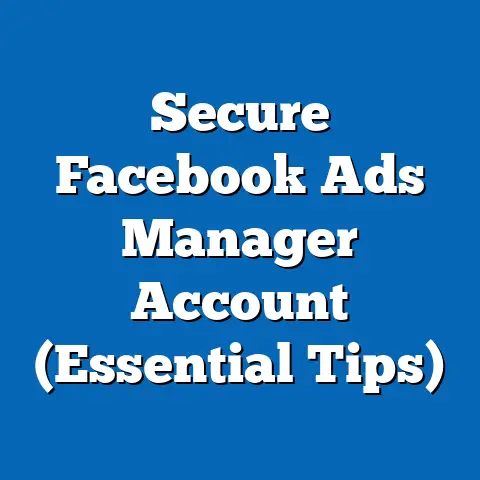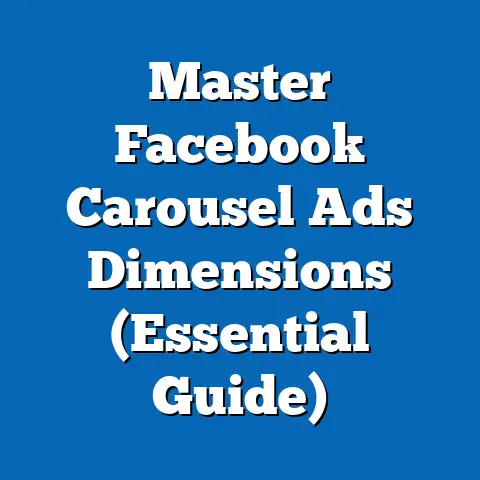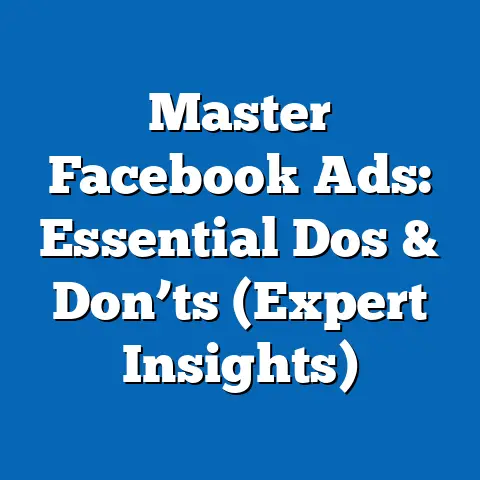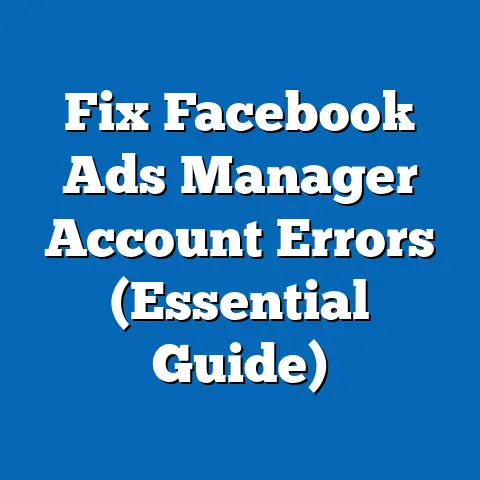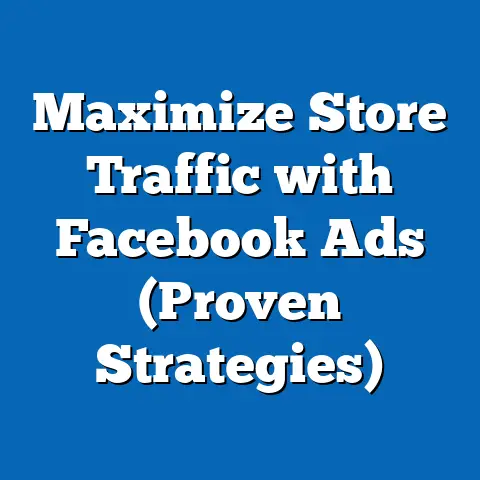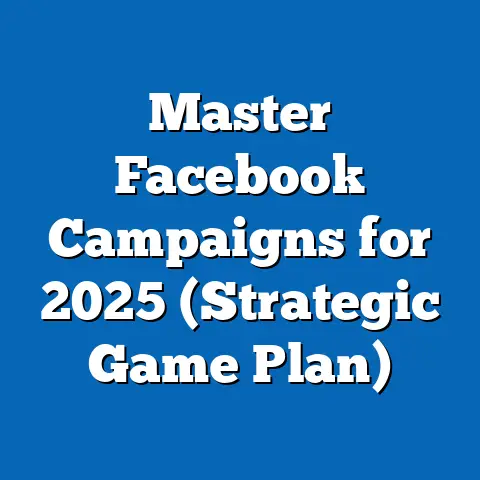Boost fb ad Clicks with Proven Strategies (Expert Insights)
The world of digital advertising is in constant flux, and Facebook, now Meta, remains a dominant force. But with every brand vying for attention, how do you make your ads stand out and, more importantly, get those crucial clicks? In my years of experience managing Facebook ad campaigns for businesses of all sizes, I’ve seen firsthand what works and what doesn’t. It’s not just about throwing money at the platform; it’s about understanding the nuances, leveraging data, and crafting compelling experiences that resonate with your target audience.
Clicks are the lifeblood of any successful Facebook ad campaign. They are the initial interaction, the first step towards conversion, and a vital indicator of your ad’s relevance and appeal. A higher click-through rate (CTR) means more website traffic, increased brand visibility, and ultimately, greater opportunities for sales and revenue. In today’s competitive landscape, simply having an ad isn’t enough. You need to actively work to boost your click-through rates to truly maximize your ROI.
This guide is designed to equip you with proven strategies, backed by expert insights and real-world examples, to dramatically improve your Facebook ad performance. I’m not just going to give you a list of tips; I’m going to walk you through the “why” behind each strategy, empowering you to make informed decisions and create campaigns that drive meaningful results.
Understanding Your Audience
Before you even think about crafting an ad, you need to intimately understand who you’re trying to reach. This isn’t just about knowing their age and location; it’s about delving into their interests, behaviors, pain points, and motivations. Data-driven insights are the foundation of any successful Facebook ad campaign.
According to a recent study by HubSpot, personalized ads deliver 6x higher transaction rates than generic ads. This underscores the importance of tailoring your messaging to specific audience segments. As marketing guru Seth Godin famously said, “Marketing is no longer about the stuff that you make, but about the stories you tell.” Your ads need to tell a story that resonates with your audience, and you can’t do that without understanding them first.
Creating Buyer Personas
Buyer personas are fictional representations of your ideal customers. They go beyond basic demographics and delve into the psychological and behavioral aspects that drive purchasing decisions. When creating buyer personas, consider factors such as:
- Demographics: Age, gender, location, income, education
- Interests: Hobbies, passions, favorite brands, online communities
- Pain Points: Challenges, frustrations, unmet needs
- Motivations: Goals, aspirations, desires
- Purchase Behaviors: How they research products, where they buy, what influences their decisions
For example, let’s say you’re selling organic skincare products. One of your buyer personas might be “Eco-Conscious Emily,” a 35-year-old woman who is passionate about sustainability and healthy living. She’s willing to pay a premium for products that are ethically sourced and environmentally friendly. Understanding this persona allows you to craft ads that highlight the organic ingredients, sustainable packaging, and cruelty-free practices of your skincare line, directly appealing to her values and motivations.
Utilizing Facebook Analytics
Facebook Insights and analytics tools are invaluable resources for refining your audience targeting and improving ad relevance. These tools provide a wealth of data about your existing audience, including:
- Demographics: Age, gender, location, education
- Interests: Pages they like, topics they engage with
- Behaviors: Purchase history, device usage, online activity
By analyzing this data, you can identify patterns and trends that inform your targeting strategy. For example, you might discover that a significant portion of your audience is interested in yoga and meditation. This insight allows you to target ads specifically to users who have expressed interest in these topics, increasing the likelihood of engagement and clicks.
Takeaway: Invest time in understanding your audience. Create detailed buyer personas and leverage Facebook analytics to refine your targeting strategy. This will ensure that your ads are reaching the right people with the right message.
Crafting Compelling Ad Copy
Once you have a solid understanding of your audience, it’s time to craft ad copy that captures their attention and compels them to click. This is where the art of persuasive language comes into play.
Power of Persuasive Language
Your ad copy should be clear, concise, and persuasive. It should immediately grab the reader’s attention and communicate the value of your offer. Here are some key principles to keep in mind:
- Headline: The headline is the first thing people see, so make it count. Use strong verbs, numbers, and questions to pique their interest. For example, “Discover the Secret to Glowing Skin” or “5 Tips for a More Productive Day.”
- Body Copy: The body copy should expand on the headline and explain the benefits of your offer. Focus on solving their problems and addressing their needs. Use clear and concise language that is easy to understand.
- Social Proof: Incorporate social proof elements, such as testimonials, reviews, and case studies, to build trust and credibility.
Incorporating Emotional Triggers
Emotions play a powerful role in decision-making. By tapping into the emotions of your target audience, you can create ads that resonate on a deeper level and drive more clicks. Some common emotional triggers include:
- Fear of Missing Out (FOMO): Create a sense of urgency and scarcity to encourage immediate action. For example, “Limited Time Offer – Don’t Miss Out!”
- Curiosity: Tease the reader with a hint of information and encourage them to click to learn more. For example, “The One Thing You’re Missing in Your Business.”
- Happiness: Associate your product or service with positive emotions like joy, excitement, and fulfillment. For example, “Experience the Freedom of Financial Independence.”
I remember working with a local restaurant that was struggling to attract customers. We created a Facebook ad campaign that featured mouthwatering photos of their signature dishes, accompanied by copy that evoked feelings of warmth, comfort, and nostalgia. The ad resonated deeply with the local community, and the restaurant saw a significant increase in reservations and foot traffic.
Call to Action (CTA)
A strong call to action is essential for driving clicks. Your CTA should be clear, concise, and action-oriented. It should tell the reader exactly what you want them to do. Some effective CTAs include:
- “Learn More”
- “Shop Now”
- “Sign Up”
- “Get Started”
- “Download Now”
Make sure your CTA is visually prominent and easy to click. Use a button or a contrasting color to make it stand out. You should also tailor your CTA to the specific offer and the stage of the customer journey. For example, if you’re promoting a free ebook, “Download Now” is a more appropriate CTA than “Shop Now.”
Takeaway: Craft compelling ad copy that captures attention, resonates with your audience, and includes a strong call to action. Use persuasive language, emotional triggers, and social proof to maximize your click-through rates.
Visual Elements that Captivate
In the visually-driven world of social media, your ad’s visual elements are just as important as the copy. In fact, studies have shown that visuals can significantly enhance engagement rates and drive more clicks.
Importance of Visuals
According to a study by HubSpot, content with relevant images gets 94% more views than content without relevant images. This highlights the importance of using high-quality, eye-catching visuals in your Facebook ads. Visuals are the first thing people see, and they play a crucial role in capturing their attention and communicating your message.
Best Practices for Visual Content
Here are some best practices for selecting and creating visual content for your Facebook ads:
- Use High-Quality Images: Choose images that are clear, well-lit, and visually appealing. Avoid using blurry or pixelated images.
- Use Relevant Images: Make sure your images are relevant to your offer and your target audience. Use images that evoke emotions and tell a story.
- Use Contrasting Colors: Use colors that contrast with the Facebook interface to make your ad stand out.
- Use Videos: Videos are a highly engaging format that can capture attention and communicate your message effectively. Keep your videos short and concise, and make sure they are optimized for mobile viewing.
- Brand Consistency: Ensure your visuals align with your brand identity. Use consistent colors, fonts, and imagery to create a cohesive brand experience.
A/B Testing Visuals
A/B testing is a powerful technique for determining which visual elements resonate best with your audience. By testing different images, videos, and ad formats, you can identify the most effective visuals for driving clicks.
For example, you might test two different images for the same ad: one featuring a product shot and another featuring a lifestyle shot. By tracking the click-through rates of each ad, you can determine which image is more effective at capturing attention and driving clicks.
I once worked with an e-commerce client that was struggling to generate sales through Facebook ads. We ran an A/B test with two different video ads: one featuring a product demonstration and another featuring customer testimonials. The customer testimonial video outperformed the product demonstration video by a significant margin, resulting in a dramatic increase in sales.
Takeaway: Invest in high-quality, visually appealing content that captures attention and communicates your message effectively. A/B test different visual elements to determine what resonates best with your audience.
Utilizing Targeting and Retargeting Options
Facebook’s advanced targeting and retargeting options allow you to reach the most relevant users with your ads, increasing the likelihood of engagement and clicks.
Advanced Targeting Features
Facebook offers a wide range of targeting options, including:
- Demographic Targeting: Target users based on age, gender, location, education, income, and other demographic factors.
- Interest-Based Targeting: Target users based on their interests, hobbies, and passions.
- Behavioral Targeting: Target users based on their online behavior, such as purchase history, device usage, and website visits.
- Custom Audiences: Create custom audiences based on your existing customer data, such as email lists and website visitors.
- Lookalike Audiences: Create lookalike audiences based on your existing customer data. Facebook will identify users who share similar characteristics and behaviors with your existing customers.
By combining these targeting options, you can create highly targeted audiences that are more likely to engage with your ads.
Retargeting Strategies
Retargeting is the practice of showing ads to users who have previously interacted with your brand. This is a highly effective strategy for capturing users who have shown interest in your products or services but haven’t yet made a purchase.
Some effective retargeting strategies include:
- Website Retargeting: Show ads to users who have visited your website but haven’t completed a purchase.
- Engagement Retargeting: Show ads to users who have engaged with your Facebook page or ads.
- Video Retargeting: Show ads to users who have watched your videos on Facebook.
Retargeting ads are often more effective than traditional ads because they are shown to users who are already familiar with your brand and have expressed interest in your products or services.
Dynamic Ads
Dynamic ads are personalized ads that are tailored to individual user preferences. They are particularly effective for e-commerce businesses that have a large product catalog.
With dynamic ads, you can automatically show users products that they have previously viewed on your website or products that are similar to those they have shown interest in. This level of personalization can significantly enhance the likelihood of clicks and conversions.
Takeaway: Leverage Facebook’s advanced targeting and retargeting options to reach the most relevant users with your ads. Use dynamic ads to personalize the ad experience and increase the likelihood of clicks.
Monitoring, Analyzing, and Optimizing
The final step in boosting your Facebook ad clicks is to continuously monitor, analyze, and optimize your campaigns. This is an iterative process that requires ongoing attention and effort.
Importance of Data Analysis
Data analysis is essential for understanding what’s working and what isn’t. By tracking key performance metrics, you can identify areas for improvement and make data-driven decisions to optimize your campaigns.
Key Metrics to Track
Some essential metrics related to clicks include:
- Click-Through Rate (CTR): The percentage of users who click on your ad after seeing it.
- Cost Per Click (CPC): The amount you pay each time someone clicks on your ad.
- Engagement Rate: The percentage of users who engage with your ad, such as liking, commenting, or sharing.
- Conversion Rate: The percentage of users who take a desired action after clicking on your ad, such as making a purchase or signing up for a newsletter.
By tracking these metrics, you can gain valuable insights into the performance of your ads and identify areas for improvement.
Optimization Techniques
Based on your performance data, you can implement various optimization techniques to improve your click-through rates and overall campaign performance. Some common optimization techniques include:
- A/B Testing: Test different ad copy, visuals, and targeting options to identify the most effective combinations.
- Audience Refinement: Refine your targeting based on performance data to reach the most responsive users.
- Budget Allocation: Allocate your budget to the best-performing ads and campaigns.
- Ad Scheduling: Schedule your ads to run during the times when your target audience is most active on Facebook.
- Landing Page Optimization: Ensure your landing pages are optimized for conversions. Make sure they are relevant to your ad copy, visually appealing, and easy to navigate.
Remember, optimization is an ongoing process. You should continuously monitor your campaigns, analyze your data, and make adjustments to improve your performance.
Takeaway: Continuously monitor, analyze, and optimize your Facebook ad campaigns based on performance data. Use A/B testing, audience refinement, and budget allocation to maximize your click-through rates and overall campaign performance.
Conclusion
Boosting Facebook ad clicks requires a multifaceted approach that encompasses audience understanding, compelling ad copy, captivating visuals, targeted advertising, and continuous optimization. By implementing the strategies outlined in this guide, you can significantly improve your click-through rates and drive more meaningful results from your Facebook ad campaigns.
The future of Facebook advertising is constantly evolving, with new features, technologies, and user behaviors emerging all the time. To stay ahead of the curve, it’s essential to embrace innovation, adapt to change, and continuously experiment with new strategies.
I encourage you to implement these strategies in your own campaigns and to stay informed about emerging trends in Facebook advertising. By doing so, you can maintain a competitive edge and achieve your marketing goals. The key is to remain adaptable, data-driven, and always focused on delivering value to your target audience. Good luck, and happy advertising!

